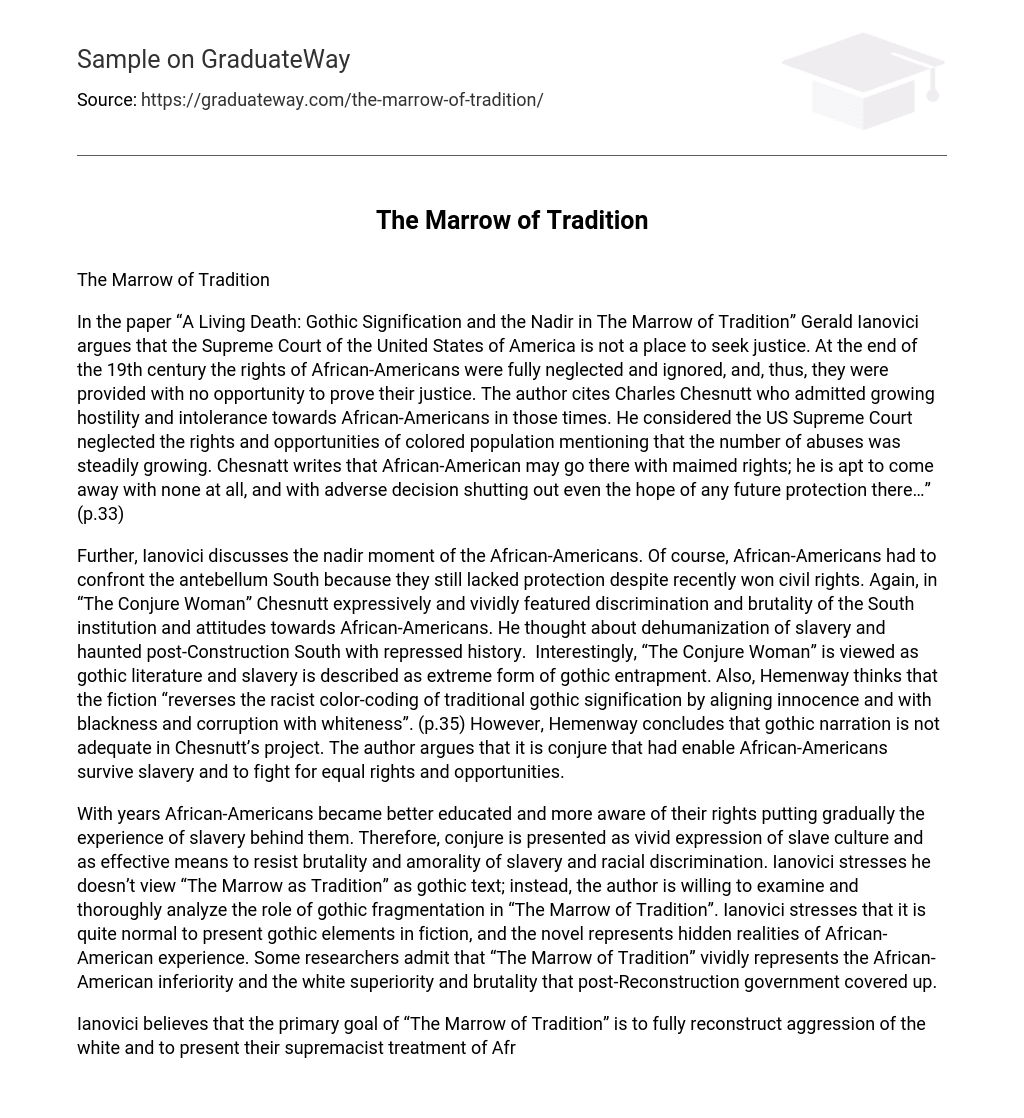In the paper “A Living Death: Gothic Signification and the Nadir in The Marrow of Tradition” Gerald Ianovici argues that the Supreme Court of the United States of America is not a place to seek justice. At the end of the 19th century the rights of African-Americans were fully neglected and ignored, and, thus, they were provided with no opportunity to prove their justice. The author cites Charles Chesnutt who admitted growing hostility and intolerance towards African-Americans in those times. He considered the US Supreme Court neglected the rights and opportunities of colored population mentioning that the number of abuses was steadily growing. Chesnatt writes that African-American may go there with maimed rights; he is apt to come away with none at all, and with adverse decision shutting out even the hope of any future protection there…” (p.33)
Further, Ianovici discusses the nadir moment of the African-Americans. Of course, African-Americans had to confront the antebellum South because they still lacked protection despite recently won civil rights. Again, in “The Conjure Woman” Chesnutt expressively and vividly featured discrimination and brutality of the South institution and attitudes towards African-Americans. He thought about dehumanization of slavery and haunted post-Construction South with repressed history. Interestingly, “The Conjure Woman” is viewed as gothic literature and slavery is described as extreme form of gothic entrapment. Also, Hemenway thinks that the fiction “reverses the racist color-coding of traditional gothic signification by aligning innocence and with blackness and corruption with whiteness”. (p.35) However, Hemenway concludes that gothic narration is not adequate in Chesnutt’s project. The author argues that it is conjure that had enable African-Americans survive slavery and to fight for equal rights and opportunities.
With years African-Americans became better educated and more aware of their rights putting gradually the experience of slavery behind them. Therefore, conjure is presented as vivid expression of slave culture and as effective means to resist brutality and amorality of slavery and racial discrimination. Ianovici stresses he doesn’t view “The Marrow as Tradition” as gothic text; instead, the author is willing to examine and thoroughly analyze the role of gothic fragmentation in “The Marrow of Tradition”. Ianovici stresses that it is quite normal to present gothic elements in fiction, and the novel represents hidden realities of African-American experience. Some researchers admit that “The Marrow of Tradition” vividly represents the African-American inferiority and the white superiority and brutality that post-Reconstruction government covered up.
Ianovici believes that the primary goal of “The Marrow of Tradition” is to fully reconstruct aggression of the white and to present their supremacist treatment of African-Americans. In other words, the novel symbolizes “how Negro domination is used to repress the fact of interracial political alliance”. (p. 38) However, repression and discrimination was still present in establishing post-Reconstruction South as many whites denied consensual interracial alliance. Of course, Chesnutt undermines racial difference revealing that whiteness merely suggests racial purity. Moreover, the whiteness of mulattos and their legitimacy were under debate as well. In the novel the New South is depicted as a nightmare state that criminalizes and discriminates blackness promoting racial whiteness and purity. African-American success was criminalized as well. Thus, African-Americans were entailed with inherent inferiority that was passing from one generation to another. Summing up, “The Marrow of Tradition” underlines that racial categories represented vividly the South’ salvation, not the gothic undoing.





